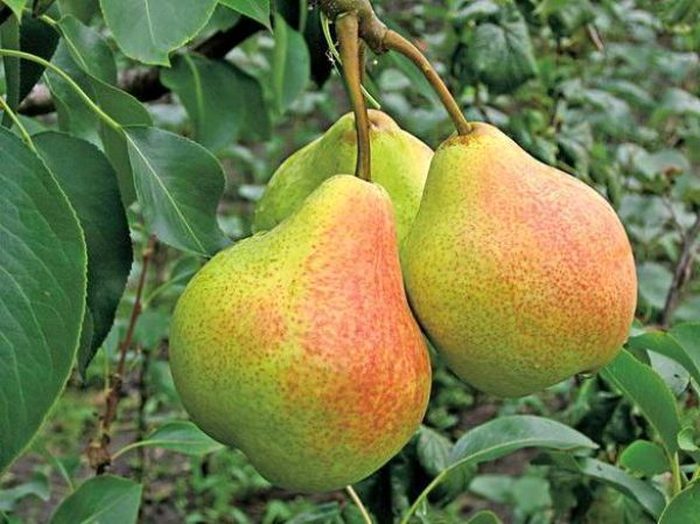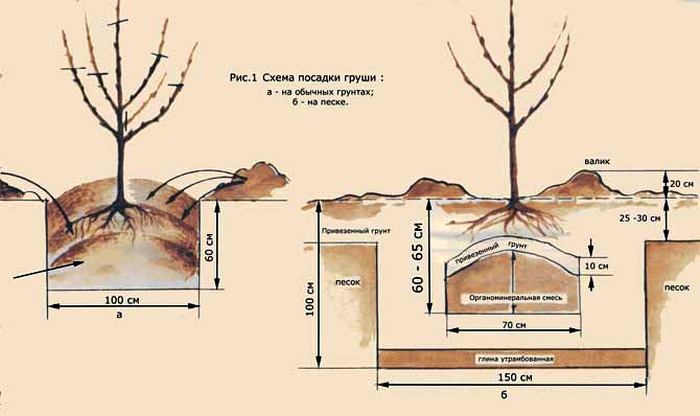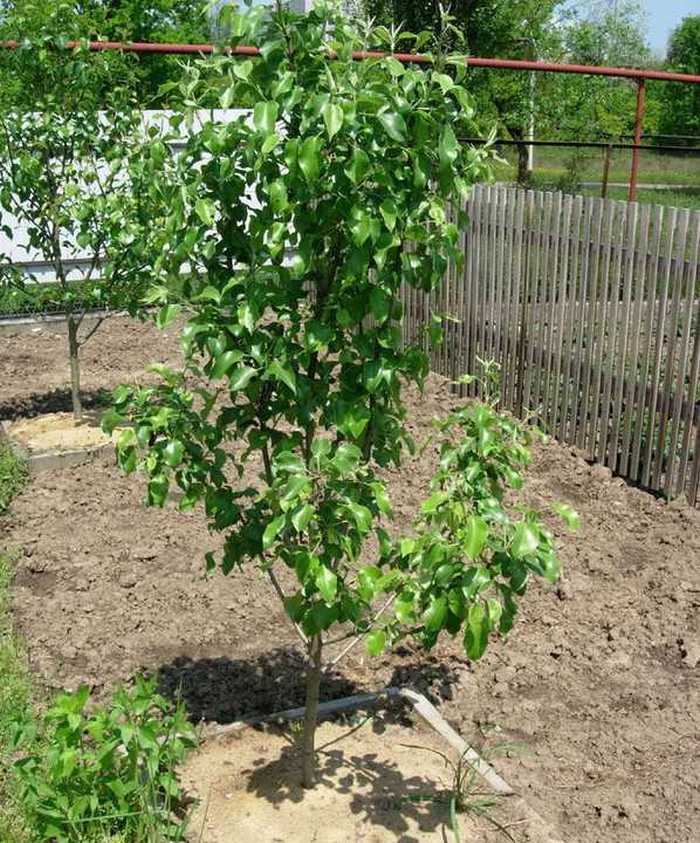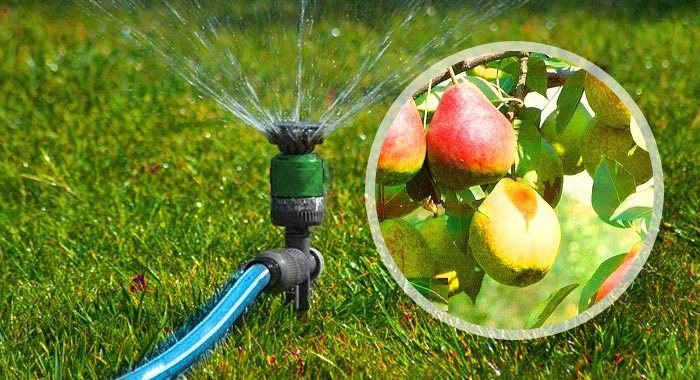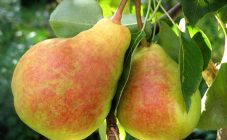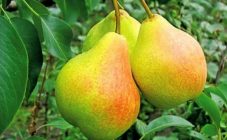Content:
Among fruit trees, the pear takes one of the first places. Early autumn varieties are especially popular. One of them is the pear in memory of Yakovlev, also known among the inhabitants as the Beauty of Yakovleva or Lyubimitsa Yakovlev. This variety was obtained by crossing such varieties as Olivier de Serre and Tema. The variety is widespread in household plots and nurseries throughout the country.
Description of the variety
A mature tree reaches a small height (2.5 - 3.0 m). It can grow quite quickly. Its crown has the shape of a small ball, with an average density of branches. Branches depart from the trunk almost at right angles.
The bark of the shoots is light brown. The leaf blades are small, ovoid. Their edges are slightly jagged. In spring, white flowers with 6 petals appear on the tree, collected in inflorescences.
Naturally, a complete description of the pear variety Krasavitsa Yakovleva is impossible without the characteristics of the fruits:
- The mass of one pear reaches 110 - 130 grams.
- The pear skin is smooth and shiny. During maturity, the skin acquires a golden color.
- The juicy, creamy pulp has a pleasant sweet aftertaste.
- The fruits of the Yakovlev pear contain a large amount of arbutin, which gives them antimicrobial properties.
- The tasting score of this variety reaches 4.4.
Pear Yakovleva's favorite ripens in early autumn. The fruiting period begins 4 years after planting the seedling. From an adult tree, you can get from 18 to 21 kg of fruit.
The fruits can be used fresh, as well as for making preserves, compotes and jams. Pears are well stored and transported.
Trees are self-fertile. This indicates that even in the absence of pollinators, Yakovlev's pear will give quite a lot of fruits. But if the gardener wants to get the highest quality harvest, it is still recommended to plant pear trees of the Lada or Avgustovkaya varieties nearby.
Gardeners consider one of the main advantages of the Memory Yakovlev pear to be a high indicator of its winter hardiness. Trees can easily endure frosts within 28 - 38 degrees.
Features of planting and care
Before you start planting a seedling, you need to decide on the choice of a site. For a tree of this variety, a sunny place is suitable, where groundwater will be located no closer than 2.0 m from the earth's surface. If the groundwater is closer, a young tree must be planted on an artificially created hill, the height of which ranges from 40 to 60 cm.
In order to ensure good gas exchange for the pear root system, the soil on the site must be loose. It will also be an excellent prevention against the accumulation of excess moisture in the soil.
If the soil is not fertile, it needs preliminary preparation. For this, humus, wood ash and mineral fertilizers are introduced into it.
The acidity of the earth is also of great importance. A detailed description of the pear Yakovleva's favorite tells - the most optimal will be the soil, with a low or neutral pH level. On acidic soils, trees will grow slowly and yields will be low.
Sapling selection
The key to a good harvest is the right choice of seedling. To do this, experienced gardeners recommend adhering to the following rules:
- Saplings whose age has reached 2 - 3 years have the best ability to take root in a new place.
- The pear root should look healthy and free from any damage.
- The trunk should have an elastic and uniform bark.
It is better to plant pear seedlings in early autumn. Before the onset of frost, the young tree will already have time to take root and get stronger.
Planting a young pear tree
The size of the planting pit can be within 70 x 100 cm. At the bottom of the pit, it is necessary to pour 3 buckets of decayed humus and 3 tbsp. l. superphosphate. The whole mass is thoroughly mixed and compacted. In the middle of the pit, a stake is driven in, 80 - 100 cm high. It will serve as a support for the trunk of the seedling. In this state, the pit should stand for at least 3 weeks. This is necessary for the soil to settle.
Before planting, the root system of the seedling is soaked for 2 - 3 days in a chatterbox of clay and heteroauxin. Thanks to this, the roots will have time to be saturated with water, and the level of their survival rate will increase.
Then you need to remove excess soil from the planting pit in such an amount that the roots feel free in it. After that, the roots are gently straightened and covered with earth, which was previously removed from the pit. The root collar of the seedling should be 5 - 6 cm above the ground.
Form a watering circle around the tree trunk. It will be used for irrigation. The seedling is tied to a peg. The tree needs to be watered with 2 - 3 buckets of settled water. The near-stem circle is mulched using hay or dry grass.
Watering
This pear loves water, but this does not mean that the soil near the trunk must be constantly wet. Watering is carried out as the soil dries up. Otherwise, the possibility that the root system will rot is not excluded.
Water a newly planted tree once a week with 2 buckets of water. It is recommended to divide this amount of water into 2 parts and water it in the morning and in the evening. An adult tree is watered twice a month with 3 buckets of water.
The pear must be watered well three times per season (regardless of rainfall):
- before flowering;
- during the formation of the ovary;
- before the onset of winter (but before frost).
After each watering, the soil near the trunk is loosened. Thanks to this, oxygen is able to freely penetrate to the root system.
Pear tree feeding
You can feed the Yakovlev memory pear with both mineral and organic fertilizers. The first time you can apply fertilizers for 2 years after planting the seedling. Until that time, the tree has enough of the top dressing that was introduced into the planting pit.
- In spring, a solution of urea and carbamide is used as fertilizer. Spring feeding is performed immediately after the snow melts. After the end of the flowering period, the pear is fertilized with nitroammophos, dissolved in water (50 g \ 10 l of water). To stimulate the development of the ovary, the pear with the onset of spring is fed with potassium sulfate (10g / 10 l of water).
- In the summer, foliar feeding of trees is carried out. It is carried out with the aim of eliminating the lack of trace elements and as a prevention of infection with diseases of fruit trees. For this, urea or Kemira's drug is used.
- In the fall, when digging the soil, you can add wood ash to it. In addition, in the process of preparing the tree for winter, the earth is fertilized with superphosphate (35 g / 10 l of water). Before the onset of winter, organic fertilizers, manure or humus are applied under the tree.
The gardener can determine the lack of vitamins or trace elements independently, by the appearance of the pear.If there is a lack of nitrogen, young leaves are pale or yellowish in color, and the fruits fall off too early.
With a lack of phosphorus, leaf blades develop poorly and have a sharply green color. Leaves become smoky with a lack of potassium. If there is not enough iron, the leaves wilt and then dry out.
Formation
The crown of this variety needs to be shaped. It is best done in the first spring. This removes the central branches up to a length of 65 cm. The first tier is formed from cut young shoots. Experienced gardeners leave 2 to 3 strong branches. All other shoots are cut off completely.
For good fruiting, other types of pruning can also be carried out:
- Sanitary. Performed as needed. This removes dried and diseased branches.
- Thinning. Held in early spring. It consists in removing branches that have grown inward. This type of pruning promotes the flow of sunlight to the fruit and improves the quality of the crop.
Since the pear variety in Memory of Yakovlev has the ability to endure even the most severe frosts, there is no need to cover adult and healthy trees for the winter. It is enough just to wrap the barrel with insulation.
If we talk about seedlings, their near-trunk circle must be sprinkled with a layer of peat 20 cm thick, and the trunk and skeletal branches are covered with a heater that has air permeability.
With proper care and planting, the Yakovlev Memory Pear is a real gift for every gardener. Almost everyone likes ripe fruits: children, adolescents, adults and the elderly. Contraindications to the use of pears are extremely rare, which means that the harvest will delight the whole family.
